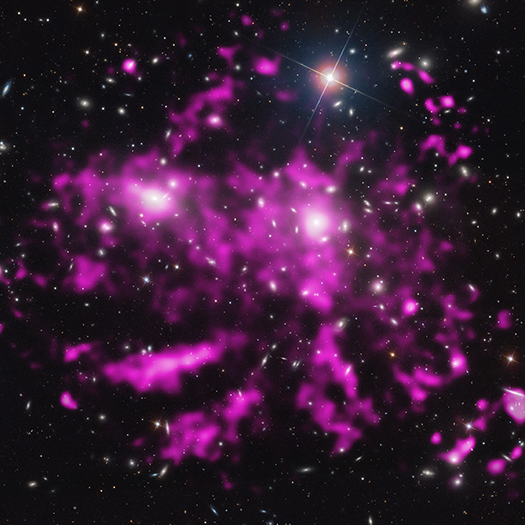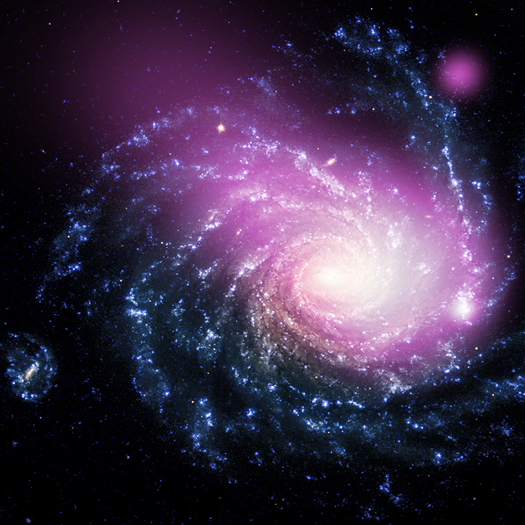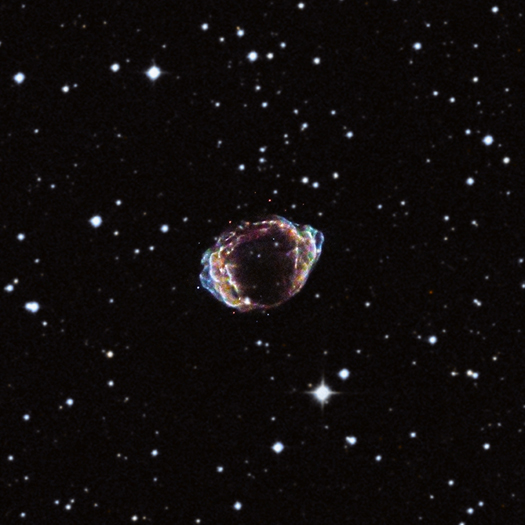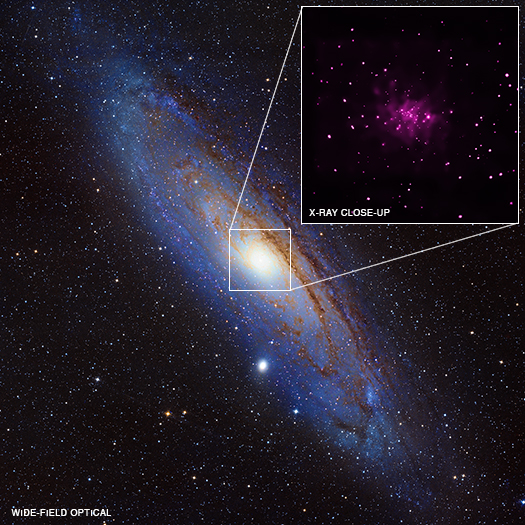Submitted by chandra on Thu, 2013-09-19 10:04

A team of astronomers has discovered enormous arms of hot gas in the Coma cluster of galaxies by using NASA's Chandra X-ray Observatory and ESA's XMM-Newton. These features, which span at least half a million light years, provide insight into how the Coma cluster has grown through mergers of smaller groups and clusters of galaxies to become one of the largest structures in the Universe held together by gravity.
A new composite image, with Chandra data in pink and optical data from the Sloan Digital Sky Survey appearing in white and blue, features these spectacular arms. In this image, the Chandra data have been processed so extra detail can be seen.
Submitted by chandra on Wed, 2013-08-28 11:00
We are delighted to welcome Q. Daniel Wang as a guest blogger today. Daniel is the first author of a paper dissecting the X-ray-emitting gas around the center of our Galaxy, the subject of our latest press release. He is a professor in astronomy at University of Massachusetts Amherst. He was the Principal Investigator of the first large-scale Chandra and Hubble surveys of the Galactic center to explore various components of this exotic ecosystem. He recently enjoyed a four-month stay at University of Cambridge as a Beverley Sackler Distinguished Visiting astronomer, where much of the work reported in the paper was finished.
It has been known for a while that almost all massive galaxies contain a giant black hole at their centers. Most of such black holes, including the one at the center of our own Galaxy, are, however, far dimmer than quasars typically seen in the early universe. This dimness cannot simply be explained by decreasing amounts of material that the black holes could capture. Have the black holes lost their appetite? Or do they just swallow everything that is captured without much radiation? Many theories have been developed. But direct observational tests are hard to come by.
Submitted by chandra on Wed, 2013-08-14 10:36

Observations with NASA's Chandra X-ray Observatory have revealed a massive cloud of multimillion-degree gas in a galaxy about 60 million light years from Earth. The hot gas cloud is likely caused by a collision between a dwarf galaxy and a much larger galaxy called NGC 1232. If confirmed, this discovery would mark the first time such a collision has been detected only in X-rays, and could have implications for understanding how galaxies grow through similar collisions.
Submitted by chandra on Tue, 2013-07-30 17:41
We are delighted to welcome Katja Poppenhaeger as a guest blogger today. Katja is the first author of a new paper describing the first exoplanet transit ever seen in X-rays, the subject of our latest press release. Katja studied physics at Frankfurt University in Germany, followed by a PhD in astrophysics at Hamburg Observatory in Germany, before coming to Harvard-Smithsonian Center for Astrophysics (CfA) as a postdoc.
Submitted by chandra on Thu, 2013-07-25 10:45
Fourteen years ago this week, NASA's Chandra X-ray Observatory was launched into space on the space shuttle Columbia. I didn't witness this spectacular event, but I know many who did. Those who had worked on Chandra's development for many years must have experienced a powerful mixture of nerves, excitement and satisfaction.
Submitted by chandra on Mon, 2013-07-15 16:37
It's the height of summer here in the Northern Hemisphere, so that means there isn't a better time for the Carnival (of Space, that is)!

Image Credit: Rrinsindika, Wikimedia Commons (Creative Commons)
Submitted by chandra on Tue, 2013-07-09 22:19
Submitted by chandra on Wed, 2013-07-03 16:39
Note: An earlier version of this article appeared on this blog by Peter Edmonds.
Last week at the Chandra X-ray Center we celebrated July 4th a week early with this new image of cosmic fireworks. This is G1.9+0.3, the youngest remains - as seen from Earth - of any supernova in our galaxy. If gas and dust had not heavily obscured it, the supernova would have been visible from Earth just over a century ago.
Submitted by chandra on Wed, 2013-06-26 10:24

Astronomers estimate that a star explodes as a supernova in our Galaxy, on average, about twice per century. In 2008, a team of scientists announced they discovered the remains of a supernova that is the most recent, in Earth's time frame, known to have occurred in the Milky Way.
Submitted by chandra on Wed, 2013-06-12 10:45

Data from NASA's Chandra X-ray Observatory have been used to discover 26 black hole candidates in the Milky Way's galactic neighbor, Andromeda, as described in our latest press release. This is the largest number of possible black holes found in a galaxy outside of our own.
Pages